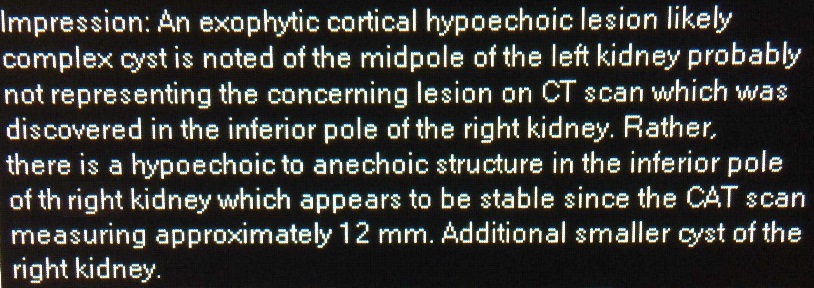 Example Sentence 1: Impression: An exophytic cortical hypoechoic lesion likely complex cyst is noted of the midpole of the left kidney probably not representing the concerning lesion on CT scan which was discovered in the inferior pole of the right kidney.
Example Sentence 1: Impression: An exophytic cortical hypoechoic lesion likely complex cyst is noted of the midpole of the left kidney probably not representing the concerning lesion on CT scan which was discovered in the inferior pole of the right kidney.
Sentence 1 review: “An exophytic cortical hypoechoic lesion” are restated findings, not impressions. It’s not until the second line, beginning “complex cyst”, do we hear the radiologist’s impression. Next, the report restates another finding (location = “midpole”).
-“which was discovered” is a long way of saying “found”
a few side notes to this point
- “is noted” – doesn’t help, remove.
- there is no “midpole”. By definition the poles are “each extremity of the axis”. There are only two poles; no midpole. I just say “mid-” as in 4 cm cyst mid left kidney or 4 cm mid left renal cyst.
- the first example sentence is long and has multiple prepositional phrases (of the, of the, in the, of the)
But then the report takes a twist. After restating findings and impression of a left-sided cyst, the author says “probably not representing the concerning lesion on CT”. This is a long sentence to end by saying the finding is NOT the important finding. Better to start by saying what is the important finding.
Also, the author describes a mid left renal lesion, and says it probably doesn’t represent the right lower pole renal lesion seen on prior CT. Probably? How could a left renal lesion ever represent a right renal lesion?
Example Sentence 2: Rather, there is a hypoechoic to anechoic structure in the inferior pole of the right kidney which appears to be stable since the CAT scan measuring approximately 12 mm.
-“there is a hypoechoic to anechoic structure” – is a restatement of findings. No impression is given (cyst or solid) for this lesion.
-“inferior pole”; say lower pole instead. Also say upper pole instead of superior pole. Upper and lower are 2 syllable words, superior and inferior are 4 syllable words.
-does the CAT scan measure 12 mm? Put adjectives close to the words the modify. Example sentence 2 would be less ambiguous if it began “Rather, there is a 12 mm hypoehoic to anechoic structure…”
Example Impression:
Impression: An exophytic cortical hypoechoic lesion likely complex cyst is noted of the midpole of the left kidney probably not representing the concerning lesion on CT scan which was discovered in the inferior pole of the right kidney. Rather, there is a hypoechoic to anechoic structure in the inferior pole of the right kidney which appears to be stable since the CAT scan measuring approximately 12 mm.
Example has a reading ease 28.9 and grade-level 17.6.
potential rewrite: Impression: Indeterminate 12 mm right lower pole kidney lesion, stable since the prior CT scan. Complex mid left renal cyst.
Edited impression has reading ease 54.7 and grade-level 8.






